Starting your baby on solid foods is a key step in their growth. Baby led weaning foods offer a great way for little ones to discover new flavors and textures while also improving their motor skills. With more than 26 years of nutrition expertise at AKFOOD, we know what worries parents and are here to provide a clear and reliable guide to introducing solids safely and with confidence.
What is Baby Led Weaning?
Baby-led weaning is a way of introducing solid foods that lets your baby decide what to eat, how much, and how fast. Instead of spoon-feeding purees, this method encourages self-feeding with baby led weaning foods—small, easy-to-hold pieces of family meals. Through this approach, babies use all their senses to explore food by touching, smelling, tasting, and feeling different textures.
This hands-on experience helps them discover food at their own pace and develop a positive, healthy attitude toward eating from the beginning. While starting baby-led weaning, breast milk or formula continues to be the main source of nutrition for babies under 12 months, making BLW a natural complement that supports a smooth transition to solid foods without losing essential nutrients.

Many parents choose a mixed approach, sometimes called “mixed feeding,” offering some pureed foods alongside self-feeding opportunities. This combination can help ease parental anxiety about nutritional intake while still providing the developmental benefits of self-feeding.
One of the greatest benefits of baby-led weaning is how it supports your baby’s physical development. Picking up food pieces, bringing them to the mouth, and learning to chew and swallow builds hand-eye coordination, strengthens facial muscles, and develops fine motor skills that extend beyond just eating.
When to Start Baby-Led Weaning?
Timing is crucial when introducing solid foods to your baby. Starting too early or too late might lead to challenges, so understanding the right moment to begin is essential for a smooth transition.
Recommended Age and Readiness Signs
Before starting baby-led weaning, it’s important to ensure your baby is developmentally ready for solid foods. This readiness typically aligns with certain milestones.
Both the World Health Organization (WHO) and the American Academy of Pediatrics (AAP) recommend introducing complementary foods at around 6 months of age. At this stage, most babies have developed the necessary skills to handle solid foods safely.
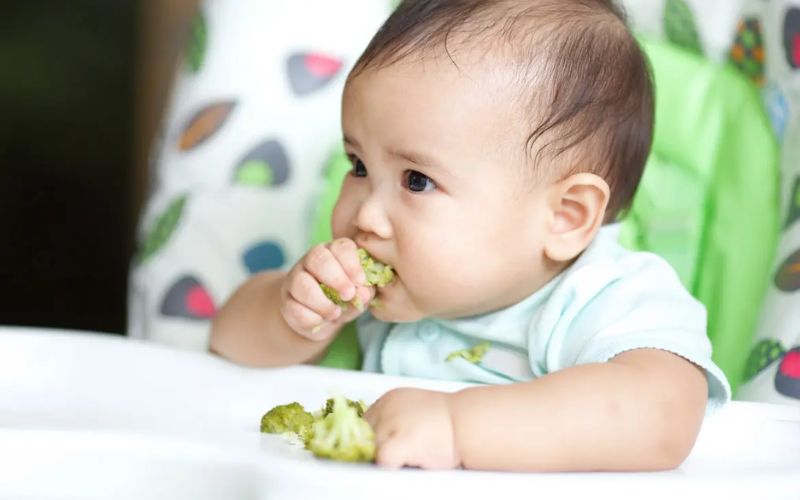
Readiness signs according to the American Academy of Pediatrics:
- Baby can sit up steadily and hold head upright: This position is crucial for reducing choking risks during eating. Your baby should be able to maintain a stable sitting position with minimal support.
- Baby has doubled birth weight: This physical milestone indicates that your baby is growing appropriately and may be ready for additional sources of nutrition beyond breast milk or formula.
- Shows interest in food and brings objects to mouth: When your baby starts watching you eat with curiosity, reaching for your food, or bringing toys and other objects to their mouth, they’re demonstrating readiness for food exploration.
- Can move food around in the mouth: The tongue-thrust reflex (which automatically pushes food out of the mouth) should have diminished, allowing your baby to move food from the front to the back of their mouth for swallowing.
Preparing for BLW
Once you’ve determined your baby is ready for baby-led weaning, proper preparation will set the stage for successful feeding sessions.
- Prepare a safe high chair with straps and foot support: Your baby needs a comfortable, secure place to eat. Choose a high chair with an upright backrest, sturdy tray, safety straps around the waist and between the legs, and foot support to provide stability. The correct seating position—with feet supported and hips and knees at 90-degree angles—creates optimal conditions for safe swallowing.
- Consult pediatrician if unsure: If you have any doubts about your baby’s readiness for solid foods, especially if your baby was born prematurely or has any health concerns, always consult with your pediatrician before starting baby-led weaning.
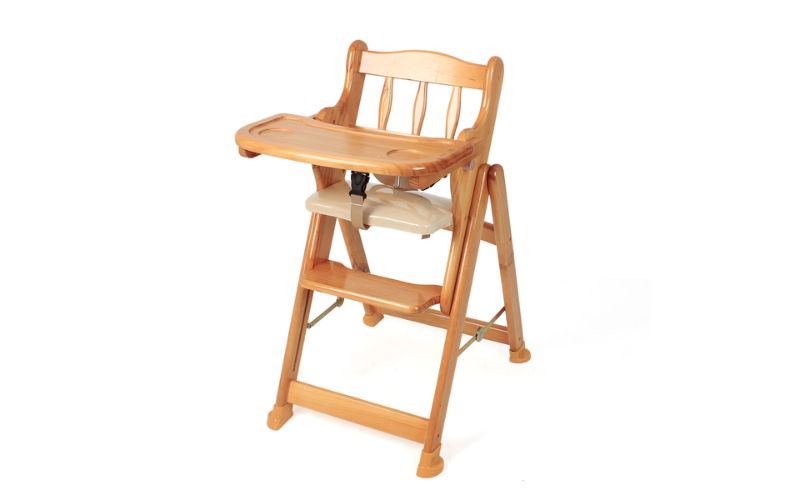
How to Begin Baby-Led Weaning
Starting the baby-led weaning journey requires patience and preparation. The first meals are more about exploration than nutrition, so approach them with flexibility and an open mind.
Starting the First Meals
The initial feeding sessions lay the foundation for your baby’s relationship with food. Creating positive experiences during these early encounters helps foster healthy eating habits.
- Start with one meal a day when your baby is alert, not too hungry or tired: Choose a time when your baby is content but not overly hungry or fatigued. Mid-morning often works well for many families, as babies are usually alert and ready to engage with new experiences.
- Seat baby comfortably in a high chair with good posture: Ensure your baby is sitting upright with good support, ideally with hips and knees at 90-degree angles. This position provides stability and reduces choking risks.
- Introduce soft, finger-sized pieces of baby led weaning foods: Offer foods cut into strips about the width of your pinky finger (approximately 2-3 inches or 5-7 cm long). This size allows your baby to hold the food with enough sticking out of their fist to eat, while being too large to fit entirely in their mouth.

- Let baby explore and self-feed without pressure: Place 1-3 food options on your baby’s tray and allow them to decide whether and how to interact with them. Avoid putting food into your baby’s mouth—the essence of baby-led weaning is self-feeding and exploration.
- Offer water in a small training cup: Introduce a small amount of water in an open cup or a straw cup during meals. This helps your baby learn the skill of drinking from a cup while staying hydrated as they explore solid foods.
- Pause and try again later if the baby shows disinterest: Not every feeding session will be a success, especially in the beginning. If your baby seems uninterested or frustrated, simply end the meal without pressure and try again another time.
Benefits of Baby-Led Weaning
Baby-led weaning offers numerous advantages for both babies and parents, supporting physical development and establishing healthy eating patterns from the start.
- Helps baby regulate hunger and fullness, reducing obesity risk: When babies control their food intake, they learn to recognize their body’s hunger and fullness cues. This self-regulation skill may help prevent overeating and reduce the risk of obesity later in life.
- Exposes baby to a variety of flavors and textures: Baby-led weaning naturally encourages offering diverse foods with different tastes and textures. This early exposure may help reduce food neophobia (fear of new foods) and promote acceptance of a wider range of healthy foods as children grow.
- Supports development of fine and gross motor skills: The process of grasping food, bringing it to the mouth, chewing, and swallowing develops hand-eye coordination, dexterity, and oral-motor skills. These physical abilities extend beyond eating to support overall development.

- Reduces mealtime stress for parents, saves time and money: With baby-led weaning, there’s no need to prepare special pureed foods or spend time spoon-feeding. Babies can generally eat modified versions of family meals, streamlining mealtime preparation and allowing everyone to eat together.
- Fosters confidence and independence in eating: Making their own decisions about food helps babies develop autonomy and confidence. This sense of capability around food can establish a positive foundation for their relationship with eating.
Safe and Nutritious First Foods for Baby-Led Weaning
Selecting appropriate foods is crucial for safe and successful baby-led weaning. The right choices provide nutrition while minimizing choking hazards.
Criteria for Choosing Baby Led Weaning Foods
When selecting foods for your baby’s first self-feeding experiences, consider these important characteristics to ensure both safety and nutritional value. The ideal first foods for baby-led weaning should be:
- Soft enough to be easily mashed between your thumb and forefinger (or between a baby’s gums)
- Shaped in a way that’s easy for small hands to grasp
- Large enough that the baby can’t put the entire piece in their mouth at once
- Rich in essential nutrients like iron, zinc, healthy fats, and vitamins
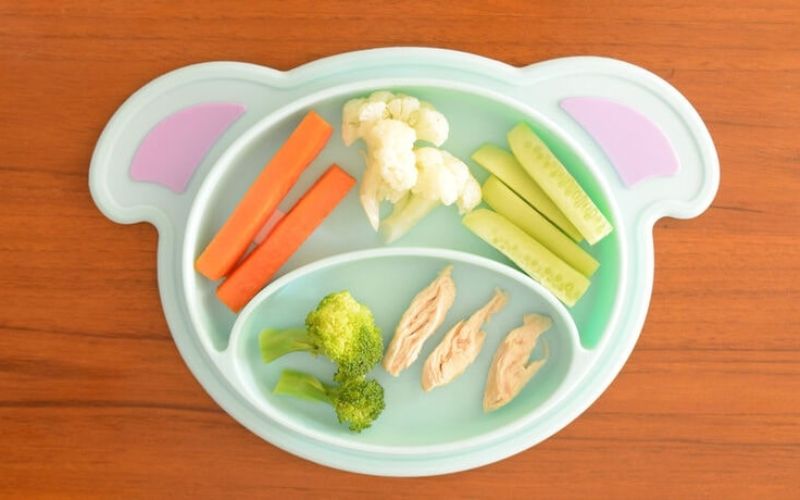
Examples of Recommended Baby Led Weaning Foods
A variety of nutrient-dense foods can be prepared appropriately for baby-led weaning, offering both sensory exploration and nutritional benefits. Here are some excellent baby led weaning first foods to consider:
- Steamed or roasted vegetables like sweet potato, carrot, broccoli, and pumpkin: Cut into sticks or wedges and cooked until soft but not mushy. These vegetables provide essential vitamins, minerals, and fiber while offering different textures for exploration.
- Soft fruits with skin on (for better grip with some types): Banana with some peel left on as a handle, ripe mango spears, melon strips, or baked apple slices offer natural sweetness and various nutrients. The skin on some fruits provides easier gripping for little hands.
- Tender meats: well-cooked beef, chicken, lamb, minced meat: Meat provides essential iron, zinc, and protein. Offer strips of well-cooked, tender meat that the baby can gnaw on, or form ground meat into patties or logs that are easy to hold.
- Iron and protein-rich foods: well-cooked eggs, tofu, boneless fish: These foods support growth and development. Hard-boiled egg wedges, strips of firm tofu, or flaked boneless fish (carefully checked for bones) make excellent protein options.
- Plain yogurt, avocado, and diluted nut butters: These foods provide healthy fats needed for brain development. Offer plain, full-fat yogurt (babies can scoop with hands), avocado strips, or toast fingers with a very thin spread of nut butter.
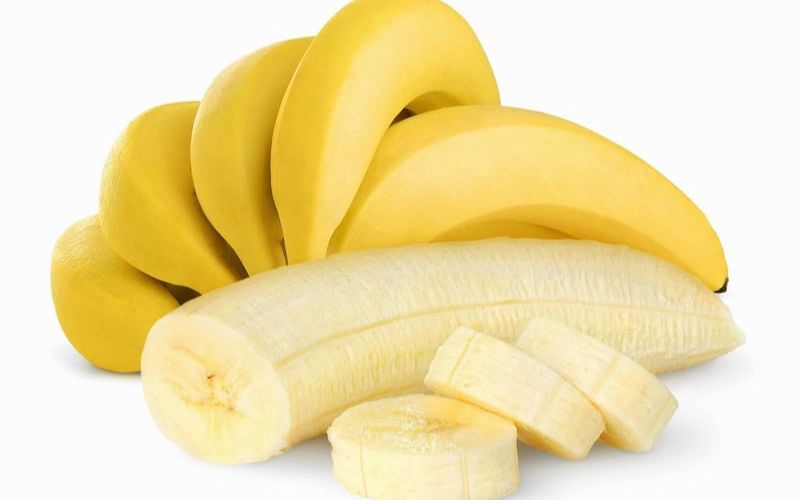
Food Preparation Tips
How you prepare and present food can significantly impact your baby’s success with self-feeding.
- Cut food into stick shapes about 4 inches long, keep skins for easier grasping: The optimal shape for early baby-led weaning foods is stick-like, about 4 inches (10 cm) long—large enough for the baby to hold with some sticking out from their fist. For some foods, leaving the skin on (like a banana or cucumber) provides a better grip.
- No need for teeth to start—gums are strong enough for soft foods: Many parents worry about their baby’s ability to eat without teeth, but baby gums are surprisingly effective at mashing and breaking down soft foods. Teeth aren’t necessary to begin baby-led weaning.
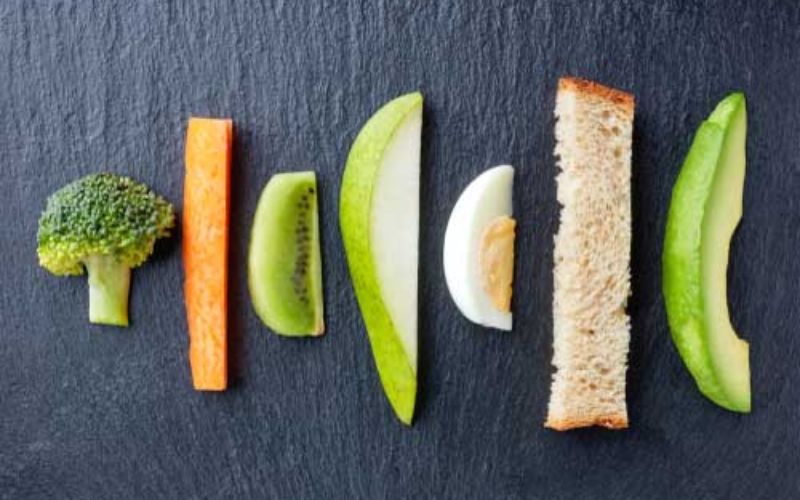
Combining Pureed Foods with Baby-Led Weaning
While traditional baby-led weaning focuses exclusively on finger foods, many families find that incorporating some pureed options creates a balanced approach.
- Offering purees with a spoon while baby self-feeds can introduce texture variety: A combined approach allows babies to experience different textures and learn both self-feeding and being fed with a spoon. You can pre-load a spoon with puree and let your baby bring it to their mouth, or alternate between spoon-feeding and offering finger foods.
- Recommended purees: mashed sweet potato, pumpkin, banana, unsweetened apple sauce, mashed beans, iron-fortified oatmeal: These nutrient-dense options work well in a mixed feeding approach. Iron-fortified cereals are particularly valuable for meeting iron needs, which become increasingly important around 6 months.
- Organic purees can be convenient options: For busy days, high-quality store-bought organic purees can be a convenient alternative to homemade options. Look for products with minimal ingredients and no added sugars or preservatives.

Foods to Avoid with Baby-Led Weaning
Understanding which foods pose safety risks is essential for protecting your baby during their eating journey.
- Hard, crunchy, sticky, or small round foods that pose choking risks: Avoid whole nuts, hard cookies, raw apple slices, thick nut butters, whole grapes, coin-shaped sliced sausages, popcorn, crispy bread, and whole seeds, as these foods present significant choking hazards.
- Salt, sugar, honey (under 12 months): Babies’ kidneys cannot process much salt, and early exposure to sugar may lead to a preference for sweet foods. Honey should be strictly avoided before 12 months due to the risk of infant botulism.
- Cow’s milk before 1 year old (as a main drink): While small amounts of cow’s milk in cooking are acceptable, it shouldn’t replace breast milk or formula before age one, as it lacks the appropriate nutritional balance for infants.
- Processed meats, fish high in mercury: Processed meats often contain excessive salt and preservatives. High-mercury fish like shark, swordfish, king mackerel, and tilefish should be avoided in favor of lower-mercury options like salmon, cod, and tilapia.
- Undercooked eggs, raw seafood, and allergy-prone foods without proper introduction: These foods pose food safety risks or require careful introduction to minimize allergy concerns.

==> Easy meatballs in honey garlic sauce recipe
Baby-Led Weaning and Choking vs. Gagging
Understanding the difference between gagging and choking is crucial for parents starting baby-led weaning, as it helps distinguish between normal reactions and emergencies.
- Understand natural gag reflex vs. dangerous choking: Gagging is a protective reflex that helps babies move food forward in their mouth if it’s too large or moves too far back too quickly. During gagging, babies may cough, have watery eyes, or look red-faced, but they can still make sounds and breathe. Choking, however, occurs when the airway is blocked, causing silence, inability to cough or cry, and potentially blue/purple skin coloration.
- Gagging is protective and normal; supervision is key: Most babies gag frequently when first starting solids, but this typically decreases as they develop better oral motor skills. Always supervise closely during meals to monitor for any true choking incidents.
- How to respond to choking emergencies: All parents and caregivers should learn basic infant first aid for choking, including back blows and chest thrusts. Consider taking a certified first aid course before starting baby-led weaning.
- Using purees can reduce anxiety for baby and parents: For families concerned about gagging or choking, incorporating some pureed foods alongside finger foods may reduce anxiety while still providing developmental benefits of self-feeding.

Safety Tips and Techniques for Baby-Led Weaning
Prioritizing safety creates an environment where babies can explore food with minimal risk.
- Always use a high chair with safety straps: A secure high chair with proper restraints ensures your baby remains in a safe, upright position throughout the meal.
- Cut baby led weaning foods into manageable stick shapes, avoid small round pieces: Food shape significantly impacts choking risk. Stick shapes allow babies to hold food while keeping most of it outside their mouth, while small round pieces can more easily block airways.
- Never leave the baby unattended while eating: Constant supervision during meals is non-negotiable. Stay within arm’s reach and maintain visual contact with your baby at all times during feeding.
- Learn basic first aid for choking: Being prepared for emergencies provides peace of mind. Take a pediatric first aid course that covers choking response, or at minimum, learn the proper technique for back blows and chest thrusts for infants.
- Consult healthcare professionals before starting: Discuss your plans to begin baby-led weaning with your pediatrician, especially if your baby has any developmental delays, feeding difficulties, or health concerns.
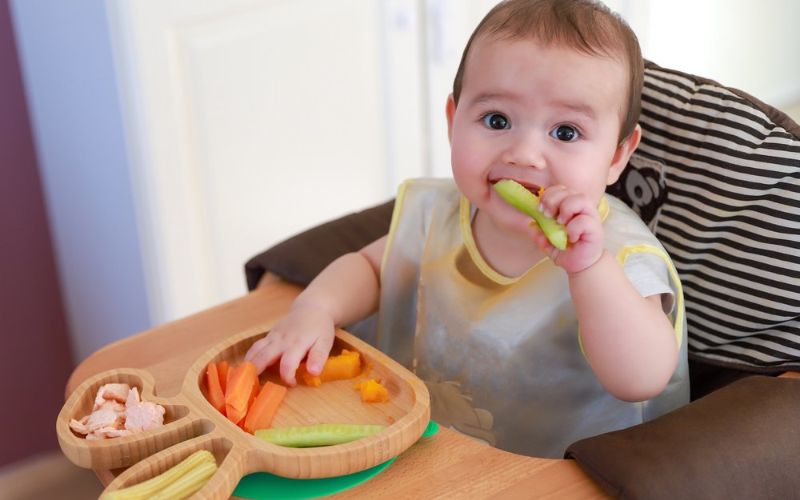
Introducing Allergenic Foods
Current research suggests early introduction of allergenic foods may help reduce allergy development in some children.
- Start early (around 6 months) with potential allergens: Common allergenic foods include peanuts (as thinned butter), eggs, seafood, soy, cow’s milk (in food), wheat, tree nuts (as thinned butters), and sesame. Current guidelines recommend introducing these foods around the same time as other solids rather than delaying.
- Introduce small amounts gradually and observe for reactions: Begin with tiny amounts of allergenic foods—just a smear or small taste—and wait a few days before increasing the amount or introducing another new allergenic food. This approach makes it easier to identify the source if a reaction occurs.
- Feed allergenic foods during the day for easy monitoring: Offer new allergenic foods in the morning or early afternoon so you can observe your baby for several hours afterward. Signs of potential allergic reactions include hives, rash, facial swelling, vomiting, diarrhea, and in severe cases, difficulty breathing.

How to Know if Baby is Eating Enough
Many parents worry about nutritional intake during baby-led weaning, but understanding your baby’s cues helps ensure they’re getting what they need.
- Signs baby is full: turning head away, refusing to open mouth, fussiness: Babies are excellent at communicating when they’ve had enough. Trust these signals and avoid pressuring them to eat more.
- This stage is exploratory; breastmilk or formula remains primary nutrition: Remember that before one year, solid foods complement but don’t replace milk feeds. Breast milk or formula continues to provide most of the calories and nutrients babies need.
- Avoid pressuring baby to finish food: Forcing a baby to eat more than they want can disrupt their natural ability to self-regulate and potentially create negative associations with eating.

Sample Baby-Led Weaning Meal Plans by Age
As babies develop, their feeding patterns and food choices evolve. These sample baby led weaning recipes and meal plans provide age-appropriate guidance for the baby-led weaning journey.
6 Months
The beginning stage of baby-led weaning focuses on exploration and introduction to simple, single-ingredient foods.
1 meal/day, soft baby led weaning foods in sticks or mashed: At this stage, offer one feeding opportunity daily with basic baby led weaning first foods like steamed carrot sticks, avocado slices, banana spears, or thick oatmeal that baby can scoop with hands.
==> How to cook carrots for baby a simple guide for healthy first foods
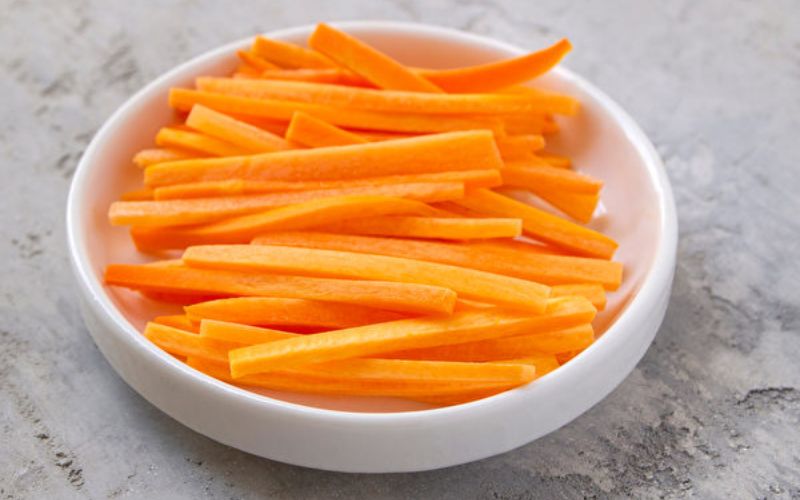
7-8 Months
As your baby becomes more comfortable with solid foods, you can gradually increase variety and frequency.
1-2 finger foods + 1 puree meal (if combining), more texture variety: Expand to 1-2 meals daily with foods like roasted sweet potato wedges, soft chicken strips, cucumber spears, scrambled egg strips, and potentially a small meal of pureed yogurt or porridge if following a mixed approach.
==> Vietnamese Chicken Porridge: A Nutritious and Delicious Meal for Your Baby
9-11 Months
During this period, babies typically develop their pincer grasp and can handle smaller food pieces.
2-3 meals/day, smaller pieces, wider food variety: Offer foods cut into smaller pieces that babies can pick up with their thumb and forefinger, like cooked peas (lightly squashed), small pieces of baked salmon, soft pasta pieces, and diced fruits.
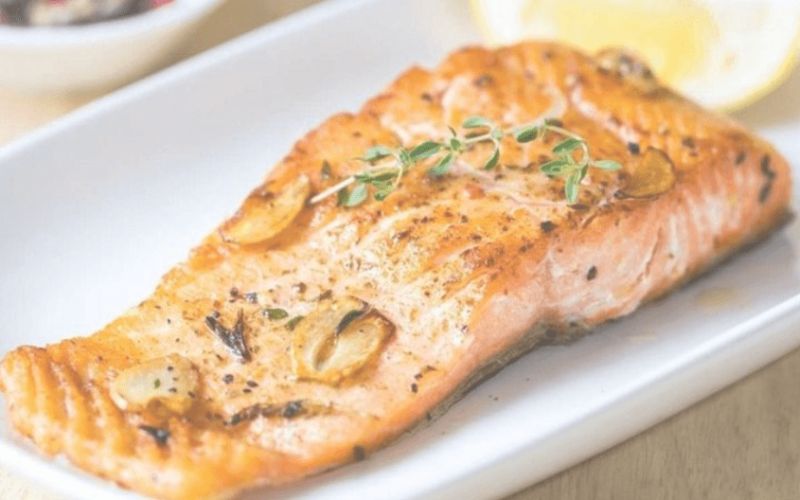
12 Months and Older
By their first birthday, babies are usually ready for a more structured eating schedule similar to the rest of the family.
- 3 main meals + 2 snacks, introduce cow’s milk or alternatives: Establish a typical meal pattern with breakfast, lunch, dinner, and 1-2 snacks. Most family foods (appropriately prepared) are suitable at this stage, and whole cow’s milk can be introduced as a drink.
- Adjust based on baby’s appetite and development: Every baby progresses at their own pace. Pay attention to your baby’s cues and adjust meal frequency, food types, and portions according to their individual needs and developmental stage.
Frequently Asked Questions (FAQ)
Addressing common concerns helps parents navigate the baby-led weaning journey with greater confidence.
Is BLW easy to do?
Baby-led weaning can be more straightforward in some ways than traditional weaning—no separate meal preparation or spoon-feeding required. However, it can also be messier and initially more anxiety-provoking for parents concerned about choking. Whether it’s “easy” depends largely on parental perspective and preparation.

When is the best age to start?
Around 6 months is typically optimal, provided your baby shows all the readiness signs: sitting upright unassisted, good head control, interest in food, and the ability to move food in their mouth.
Does a baby need teeth to start BLW?
No, teeth aren’t necessary for baby-led weaning. Babies’ gums are surprisingly effective at mashing soft foods, and many babies begin eating solids months before their first teeth emerge.
Is there a choking risk with BLW?
All methods of introducing solids carry some choking risk if proper precautions aren’t taken. Research suggests that baby-led weaning isn’t necessarily riskier than traditional spoon-feeding when parents follow safety guidelines. Understanding the difference between gagging (normal) and choking (emergency) is crucial.

How do I know if my baby is eating enough?
Monitor your baby’s growth curve at pediatric visits, count wet diapers to ensure adequate hydration, and observe their energy levels and alertness. Remember that milk feeds remain the primary nutrition source during the first year, so solid food intake will vary.
Can BLW be combined with purees?
Absolutely. Many families find a combined approach works well, offering both finger foods for self-feeding and some purees. This flexibility allows parents to address concerns about nutrition intake while still providing the developmental benefits of self-feeding.

Conclusion
Baby-led weaning offers a natural, developmentally supportive approach to introducing solid foods. By following safety guidelines, watching for readiness cues, and providing appropriate baby led weaning foods, you can create positive eating experiences that foster healthy relationships with food from the very beginning.
Remember that every baby is unique, and adapting your approach to suit your child’s individual needs and development is key to success. Trust your baby’s ability to self-regulate and explore, while maintaining appropriate supervision and support throughout the journey.
The early feeding experiences you provide set the foundation for lifelong eating habits. With patience, preparation, and an understanding of what is baby-led weaning, you can help your little one develop the skills and attitudes that support healthy nutrition for years to come. Starting with simple baby led weaning first foods and gradually expanding to more diverse baby led weaning recipes will help your child develop a positive relationship with food.
At AKFOOD, we’re committed to supporting parents through every stage of their children’s nutritional development. Our range of nutritious, high-quality products—developed with over 26 years of expertise—complements your baby-led weaning journey, providing convenient options that never compromise on quality or nutritional value.


 Tiếng Việt
Tiếng Việt